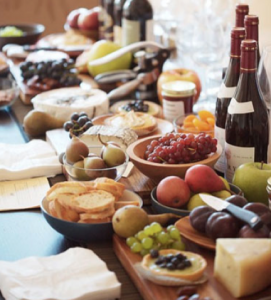 Housewares manufacturers need to adapt, inspire and motivate in order to have success with today’s ever changing consumer, Tom Mirabile said at the 2014 International Home + Housewares Show focusing on top trends.
Housewares manufacturers need to adapt, inspire and motivate in order to have success with today’s ever changing consumer, Tom Mirabile said at the 2014 International Home + Housewares Show focusing on top trends.
“Whether you’re a retailer, manufacturer or wholesaler, a single word encapsulates today’s most crucial business imperative: Adapt,” he said. “Today’s consumer lives and shops in multi-dimensional ways we couldn’t have imagined a decade ago. More importantly, they crave – no demand – innovation.”
“Sometimes these advances are tangible, delivering improved performance and expanded function, or savings of time or space. Still, it’s clear that all owe their inspiration and success to a single vital source: a fundamental understanding of the consumer. Not just their age and income, shopping habits or household composition, but an educated perspective on the lives they are living and the lives they want to live.”
Mirabile discussed several generations to illustrate how housewares manufacturers need to adapt with these top trends: social Gen Y, the strapped Gen X and active Baby Boomers.
The Gen Y generation is aged 19-37, are early technology adopters, true foodies and the most design savvy generation ever. They expect customization, and they reuse and repurpose.
“That presents a challenge to us because we are trying to sell them something new,” Mirabile said. “They want small spaces that live large, and that’s important to keep in mind as we design products for them. They are also more casual, so we have to adapt to the way that they entertain. And, they are also more frugal.
 “Gen X includes people who are practical and pragmatic, who spend more money on pet products than any other generation. They see their home as the hive and the haven where they can relax. They are ages 39-47, their salaries are depressed, and they have more debt than any other generation, so our role as adapters needs to give them good reasons to buy,” he explained.
“Gen X includes people who are practical and pragmatic, who spend more money on pet products than any other generation. They see their home as the hive and the haven where they can relax. They are ages 39-47, their salaries are depressed, and they have more debt than any other generation, so our role as adapters needs to give them good reasons to buy,” he explained.
Gen Xers seek family time and a balance of the work/life mix, so products for them have to cater to family. In addition, the generation is more fiscally prudent, as they were the chief victims of the most recent recession, so they are working harder. Meal time and good food is very important.
“Baby Boomers are defining luxury, but don’t just give them the most expensive or most desired product,” Mirabile advised, “give them products that deliver superior function and technology.” Baby Boomers are ages 48-68, and many have children or parents living with them. Some are downsizing, but not willing to sacrifice luxury.
“We need to understand baby boomers and adapt living spaces for their new interests and hobbies,” Mirabile said. “What is impressive about this generation is that the women are the healthiest and wealthiest and most active of any group of women in history. They are buying experiences, not objects. We need to adapt to their wellness desires, and to their fiscal concerns.”
 Mirabile noted that even though the most recent recession ended in 2009, many of its effects have lingered – unemployment is still high, for example. That will take even more adaptation, he said, as there have been reductions in earnings and the workforce – a slow growth era since 2009.
Mirabile noted that even though the most recent recession ended in 2009, many of its effects have lingered – unemployment is still high, for example. That will take even more adaptation, he said, as there have been reductions in earnings and the workforce – a slow growth era since 2009.
“We have to adapt by differentiating,” he said. “There are more expectations, as consumers expect more in a slow growth era. You need to deliver on a specific value platform, whether it’s price or material. On the positive side, housing stats are good, and that will grow economic confidence. We also have to adapt to e-commerce growth, as two-thirds of Americans have smart phones, and they are using them for the shopping experience. People hate that technology never shuts down and it replaces face-to-face interaction at retail, but we love that we are connected 24/7.”
Mirabile also discussed the Inspire trend, which he said is about consumer strength, more retail choices, blurred channels and categories and the socialization of food. “Those are your opportunities to inspire the consumer,” he said. “Give the consumer new ways to live and design. In all housewares categories, we are seeing a move from function to more fashion. The younger generation will embrace that trend.”
 Even more opportunities to inspire consumers include a growing ethnically diverse population and an increasing emphasis on health inspire these top trends. “Health has become one of the most important things to people, more important than a nice place to live or their money and financial situation, their community and friends, and work fulfillment. So companies and products that help consumers understand and accomplish better nutrition while minimizing time investment will have the advantage,” he said.
Even more opportunities to inspire consumers include a growing ethnically diverse population and an increasing emphasis on health inspire these top trends. “Health has become one of the most important things to people, more important than a nice place to live or their money and financial situation, their community and friends, and work fulfillment. So companies and products that help consumers understand and accomplish better nutrition while minimizing time investment will have the advantage,” he said.
Another aspect in top trends is, Motivation. Motivation is about motivating housewares sales with a clear focus on consumer inspirations, health and wellness and changing strategies.
“For example, we are in an era of fiscal conservatism, so consumers must be motivated to buy,” Mirabile said. “It is the intangibles such as experience, knowledge and skills that provide the new motivation needed to spend. In addition, meaningful differentiation is not about price and quality alone, it’s about the price, the quality, the design and the experience. It’s not about having something for everyone, it’s about products and services for a targeted audience. You need to motivate with value beyond price, and that includes brand ethics, durability, variety and design.”



